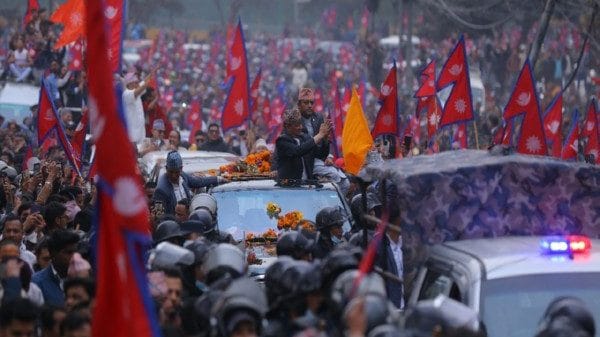When a king arrives, his people bow. The same happened on 9 March in Nepal, when former King Gyanendra Shah landed in Kathmandu from Pokhara. People shouted slogans in his support and carried a procession, igniting a fresh wave of speculation about the return of Nepal’s monarchy.
Today, Nepal is a secular republic and the crown has become a memory. Narayanhiti Royal Palace is now a museum in the heart of Kathmandu city, with a few security guards and a ticket counter for commoners if they want to experience the rich royal history.
The former king has no official jurisdiction, as the Constituent Assembly abolished monarchy in 2008. Gyanendra has no seat of power and no grand palace to command from. Instead, he resides at a former royal retreat on the outskirts of Kathmandu, living as a private citizen.
So, why the chatter?
The Shah rulers in Nepal were once revered as an incarnation of the Hindu god Vishnu. Former King Gyanendra, therefore, may have the support of the majority Hindu population. From all the chatter, it is not difficult to guess that many of his supporters see the king as a ray of hope. They believe he can bring back political stability to the country, which remains a distant dream, considering all parties want to be in power and no one in the opposition. However, for a country of over 30 million people, quantifying support for restoring the monarchy is difficult.
While around 10,000 people reportedly gathered at the Tribhuvan International Airport to welcome the former king, the number is a mere fraction of the population—hardly a decisive indicator of a nationwide shift. Social media campaigns featuring celebrities and royalists may create a buzz, but without broader public mobilisation or political backing, the monarchy’s return remains unlikely.
Disappointment with system
Since the advent of Modern Nepal in 1950, the country has cycled through political systems—traditional monarchy, Panchayat, constitutional monarchy, and now federal democracy. While monarchy ensured stability through hereditary succession, democracy—despite decentralising power—has been anything but stable. In just 17 years, Nepal has seen 13 governments, an equal number of prime ministers, more than 20 deputy prime ministers, and enough ministers to form a new party of ex-ministers.
The Maoist Centre, which once waged war against the state and monarchy, won Nepal’s first democratic elections in 2008. But its leader, Pushpa Kamal Dahal, alias Prachanda, resigned within a year after clashing with the army chief. Since then, governance has become a revolving door of instability.
Today, power struggles persist among Prachanda’s Maoists, KP Sharma Oli’s CPN-UML, Sher Bahadur Deuba’s Nepali Congress, Madhesi parties, and newcomers like Rabi Lamichhane’s Rastriya Swatantra Party. Amid this power quest, the bigger issue is that no one likes being in opposition, even if they don’t have the political mandate. Despite numbers not favouring Prachanda, he managed to lead the government in 2022 by forming a coalition with the Nepali Congress.
Nepal’s democracy came at the cost of thousands of lives lost during the Maoist insurgency and the People’s War in 2006. Yet, political parties have failed to meet public aspirations—whether in the economy, employment, infrastructure, education, or social services. Frustration with the current leadership has reignited talks of monarchy as a better alternative. Despite the family feuds, it is being said, at least the monarchy was stable.
Gyanendra ascended the throne only after the tragic royal massacre of 2001, when Crown Prince Dipendra allegedly killed King Birendra, Queen Aishwarya, and other royals over a domestic dispute. For two decades, Gyanendra has been part of the controversy, named as the orchestrator of the massacre. Meanwhile, protests against his authoritarian rule during the 2006 emergency further deepened public distrust.
Mere faith in the monarchy may not be enough to rally majority support for Gyanendra’s reinstatement as king.
Also read: Trump has a point—the world is mooching off Uncle Sam, and it is time to rebalance
Kings don’t contest elections
An alternative to the return of monarchy is that Gyanendra contests elections. While this has been discussed for a long time, Gyanendra remains a former king who still enjoys the cultural and traditional status of a royal and is connected to god. He would probably not enjoy sitting among commoners in the parliament. And history has it: Kings don’t fight elections.
Meanwhile, if Gyanendra aligns with royalist parties like the Rastriya Prajatantra Party (RPP) and leverages his influence to secure parliamentary seats in the 2027 general elections, he could still play a pivotal role in shaping Nepal’s future government. Unfortunately, the RPP has gone through a leadership crisis and has lacked unity in recent years.
Interestingly, certain sections of Gyanendra’s supporters seek backing from India, as reported in the media. But let’s consider this mere chatter.
Nepal is a sovereign country and its shift to democracy was chosen by its people. Therefore, there is little reason for India to take sides. New Delhi’s strategic interest lies in a stable and cooperative Nepal, not in interfering with the country’s internal political affairs.
However, this chatter should not go unnoticed or be seen as a simple counter to democracy. It is more about the country’s current failing leadership, where relentless power struggle has sidelined the need for stability.
Rishi Gupta is the Assistant Director of the Asia Society Policy Institute, New Delhi. He writes on the Asia-Pacific affairs, strategic Himalayas, and South Asian geopolitics. He tweets @RishiGupta_JNU. Views are personal.
(Edited by Prasanna Bachchhav)






